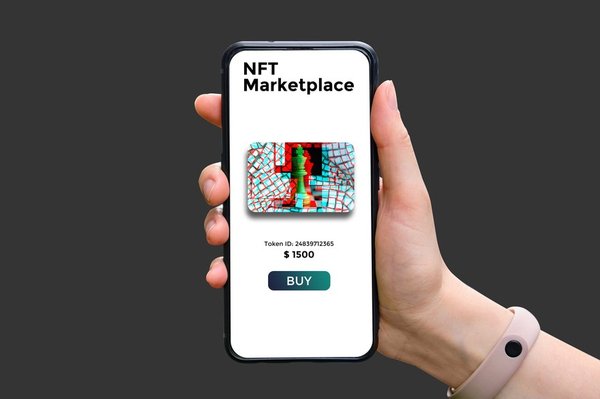Non-fungible tokens (NFTs) emerged as one of the first use cases for blockchain technology outside of cryptocurrencies. During the early COVID-19 pandemic, artists and digital creators flocked to the NFT space to cash in on the boom in digital asset sales.

Creating NFTs isn’t free, though. Some creators joined the movement only to be hit with unexpected bills in the form of NFT gas fees. Here’s what gas fees are, how they work, and how to potentially save some coin when creating digital assets.
What is it?
What is an NFT gas fee?
A gas fee is a transaction fee specific to the Ethereum (ETH -0.09%) blockchain network. Ethereum’s developer pages call these gas fees “the fuel that allows the [Ethereum network] to operate, in the same way that a car needs gasoline to run.”
As Ethereum has grown, gas fees have come to refer to other cryptocurrency and blockchain fees, as well as NFT fees. Basically, an NFT gas fee is the money paid to blockchain miners for processing the transaction that is embedded in the blockchain.
How it works
How NFT gas fees work
Blockchain technology is a digital ledger of all past transactions that have taken place on a blockchain network. The ledger is distributed among all miners, which are the powerful computers used to manage the network and verify transactions (such as when an NFT is minted or sold).
Like all computing systems, energy is used to compute these transactions. To help reimburse miners for the work they are doing, gas fees are charged whenever a transaction is requested. This applies to simple transfers of crypto (for example, when Ethereum is used as a form of payment), executing a smart contract, or when minting (creating) an NFT or selling an NFT to someone else.
Once an NFT is created on an NFT marketplace, an artist is prompted to mint the art, which creates a record of the asset on the blockchain itself. “Lazy minting” refers to creating the NFT without putting it on-chain, thus avoiding (at least temporarily) having to pay the gas fee involved.
Why are NFT gas fees high?
Why are NFT gas fees high?
NFT gas fees are variable. The price paid for a transaction depends on several metrics:
- Network activity: The more transaction requests made, the higher the fee.
- Amount of data: The larger the transaction size, the more gas used to execute it.
- Miner tip: NFT artists and buyers can pay a “tip” to a miner to have their transaction verified before other transactions waiting in the queue.
During the peak of the NFT craze in late 2021 and early 2022, some artists reported paying hundreds (even thousands) of dollars in gas fees. This is a function of how popular the Ethereum and other blockchain networks have become and elevated traffic in transaction requests. During these periods, the gas fees on many NFTs far exceeded the actual sale price of the NFT itself.
How to lower (or avoid) NFT gas fees
How to lower (or avoid) NFT gas fees
Gas fees on Ethereum have reached cost-prohibitive levels for many artists, but measures are underway to try and lower the fees. Ethereum’s “merge” to a proof-of-stake model is set to occur in the second half of 2022. Switching from a proof-of-work model (which uses more energy) to proof of stake could help lower NFT gas fees.
Although Ethereum is the most popular blockchain for digital transactions such as NFTs, there are other blockchain networks that tout lower fees. Solana (SOL -1.65%) is one of them. Although it doesn’t have the volume of NFTs of Ethereum, it has been gaining in popularity due to lower transaction costs and faster transaction computing time.
If you are a digital artist, another way to avoid paying NFT gas fees is by using “lazy minting.” As mentioned above, this is a delay in recording an NFT on a blockchain. Some NFT marketplaces allow for the creation of NFTs, listing them for sale and then paying for the gas to record the NFT on-chain once a buyer submits an offer. Once a purchase is accepted, the gas fee is paid and included in the sale price.
Another way to lower gas fees is to list multiple NFTs as a “collection,” effectively bundling the assets together and selling them as a package to a buyer. Combining multiple NFTs as one transaction also lowers the amount of gas used on the Ethereum network.
Perhaps the best way to avoid NFT gas fees, though, is by using a sidechain network. A sidechain is a separate blockchain that runs independently of a parent blockchain but is connected to the parent via a two-way peg that allows for digital asset transfers. Many sidechains allow for faster or cheaper transactions than the primary Ethereum blockchain network.
Polygon (MATIC 2.08%) is a popular Ethereum network sidechain, and some marketplaces such as OpenSea support NFT sales using it. A key feature of Polygon is that it has no NFT gas fees. This makes it an ideal solution for digital creators looking to save on the cost of minting and selling NFTs.
Related Fintech Topics
Considerations other than NFT gas fees
Bear in mind that gas fees are only one consideration when it comes to NFTs. Like all fresh technology, NFTs are still rapidly developing, and the industry is prone to fast changes. Amid broader market turmoil in 2022, the NFT space has been losing steam as speculative buyers are in shorter supply. As a result, many NFTs have been losing value.
For digital artists and collectors, price volatility is another risk to bear in mind. The crypto and blockchain industry holds a lot of promise, but it’s still early days for its development and adoption. For investors in particular, remember to keep NFTs (if any) as a small portion of a larger and well-diversified portfolio strategy.


















